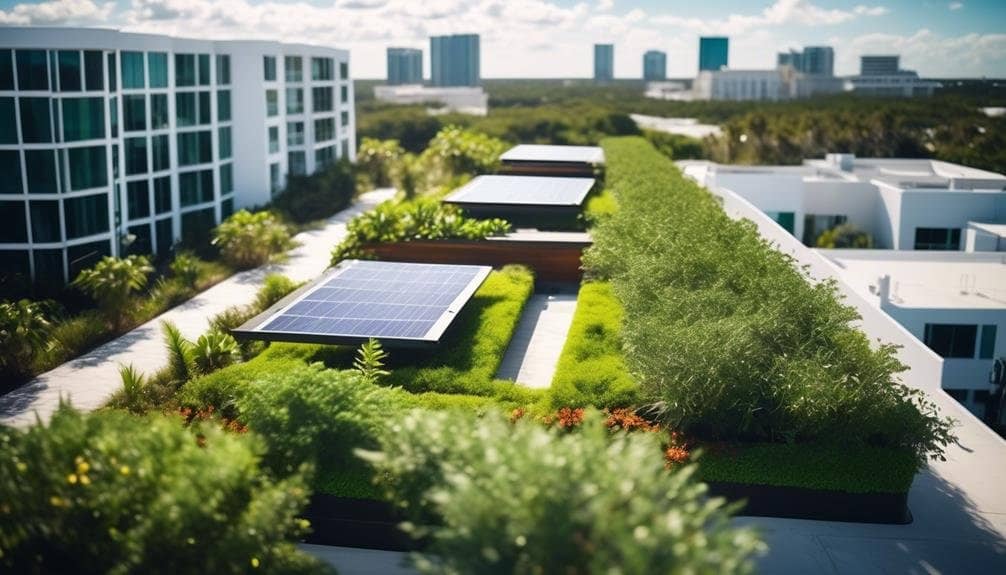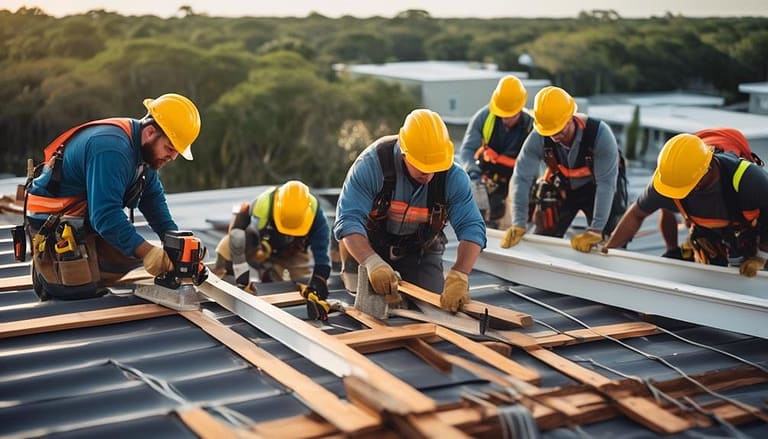Green Roofing Trends in Tampa

In Tampa, the growing popularity of green roofing is reshaping the city's skyline. Many people are prioritizing sustainability, making green roofs very appealing. What are the latest trends in green roofing in Tampa, and how might they impact the local landscape and your property? Let's explore the innovative materials, designs, and solutions that are making waves in Tampa's roofing industry, and how they could potentially revolutionize your approach to roofing. Let's use clear and straightforward language to discuss this important topic.
One of the key trends in green roofing in Tampa is the use of eco-friendly materials and designs. For example, the use of sustainable and locally-sourced vegetation and materials can significantly enhance the environmental impact of a roof. Additionally, the installation of rainwater harvesting systems and solar panels on green roofs can further contribute to sustainability.
Incorporating these features into green roofs can positively influence the local landscape by reducing energy consumption, mitigating stormwater runoff, and improving air quality. Moreover, these eco-friendly roofing solutions can also provide long-term cost savings and enhance the overall value of your property.
It's important to note that these trends are not only shaping the aesthetics of Tampa's buildings but also contributing to a more sustainable and environmentally conscious community. By embracing these innovative roofing solutions, Tampa is not only making a statement about sustainability but also setting an example for other cities to follow.
Key Takeaways
Tampa's skyline is undergoing a transformation with the increasing popularity of green roofing. Many residents are prioritizing sustainability, making green roofs highly desirable. Let's delve into the latest trends in green roofing in Tampa and how they could impact the local landscape and properties. We will explore the innovative materials, designs, and solutions that are making waves in Tampa's roofing industry and how they could potentially revolutionize your approach to roofing.
One of the key trends in green roofing in Tampa is the use of eco-friendly materials and designs. For instance, utilizing sustainable and locally-sourced vegetation and materials can significantly enhance the environmental impact of a roof. Additionally, the installation of rainwater harvesting systems and solar panels on green roofs can further contribute to sustainability.
Incorporating these features into green roofs can have a positive influence on the local landscape by reducing energy consumption, managing stormwater runoff, and improving air quality. Moreover, these eco-friendly roofing solutions can also provide long-term cost savings and enhance the overall value of your property.
It's important to note that these trends are not only shaping the aesthetics of Tampa's buildings but also contributing to a more sustainable and environmentally conscious community. By embracing these innovative roofing solutions, Tampa is not only making a statement about sustainability but also setting an example for other cities to follow. Transitioning to more sustainable roofing practices is crucial for the well-being of the community and the environment.
Sustainable Roofing Materials
Choosing sustainable roofing materials is essential for reducing energy consumption and minimizing the urban heat island effect.
Metal roofs made from recycled materials offer durability, energy efficiency, and a sleek appearance. They reflect more sunlight, keeping buildings cooler and decreasing the need for excessive air conditioning. This not only lowers energy bills but also reduces your carbon footprint. Moreover, metal roofs require minimal maintenance, making them a sustainable roofing solution that contributes to the reduction of stormwater runoff, benefiting the environment.
Tile roofs with high solar reflectance provide an energy-efficient and sustainable option for roofing. Shingle roofs made from recycled materials also play a part in environmental conservation in roofing. Additionally, asphalt roofs with cool roof coatings offer energy efficiency and sustainability benefits for buildings.
Green roofs with vegetation provide energy efficiency and environmental benefits, making them a sustainable roofing choice for those who value environmental consciousness. These options contribute to reducing the environmental impact while providing long-lasting and low-maintenance roofing solutions.
Innovative Green Roof Designs
Innovative Green Roofing Designs
When it comes to the future of green roofing, new designs are continually improving sustainability and energy efficiency by incorporating materials like metal, tile, and asphalt, along with new technologies for a more eco-friendly approach.
Here are some of the latest innovations in green roofing:
- Green roofs: These roofs include vegetation and soil, which reduce energy consumption and enhance air quality.
- Solar shingles: These shingles seamlessly integrate solar cells, producing clean energy for the home.
- Composite shingles: These shingles are made from recycled materials, offering durability and resistance to fire and harsh weather conditions.
- Metal roofing: Metal roofing is becoming increasingly popular for residential homes due to its energy efficiency, longevity, and sleek appearance.
These innovative roofing solutions not only reduce urban heat and improve air quality but also contribute to sustainable urban environments. By integrating such technologies into roofing materials, there's significant potential to decrease carbon dioxide emissions and lower air conditioning costs.
Embracing these innovations can lead to a more sustainable and energy-efficient urban landscape.
Energy-Efficient Roofing Solutions
Achieving energy efficiency in roofing involves choosing sustainable materials and using innovative technologies. Options such as green roofs, solar panel installations, and cool roofs can help reduce urban heat island effects, lower energy consumption, and improve building comfort.
In Tampa, using sustainable roofing materials like metal roofs made from recycled materials, tile roofs with high solar reflectance, and shingle roofs made from recycled materials can contribute to energy efficiency and reduce urban heat. These materials also offer benefits like reduced energy bills, lower carbon footprints, and increased property values.
Smart roofs and innovative insulation materials can further improve the energy efficiency of your roof. When selecting an energy-efficient roofing option, consider factors such as building orientation, energy savings potential, and certification from a green roofer.
To evaluate the energy efficiency of your roof, consider hiring a professional roofing inspector for an assessment, looking for signs of damage or wear that affect insulation, and determining if the roof meets local building codes for energy efficiency.
Tampa's Urban Green Initiatives
Tampa's efforts to make the city more environmentally friendly include various sustainable and energy-efficient roofing options. These choices aim to improve building comfort and lessen the environmental impact.
The options available for consideration include cool roofs, solar panel installations, green roofs, and smart roofs. These initiatives are intended to lessen urban heat, boost energy efficiency, and decrease energy use in Tampa.
Green roofs, in particular, offer numerous benefits such as enhancing air quality, serving as a natural filter for rainwater, absorbing carbon dioxide from the air, and reducing energy consumption. By embracing these green initiatives, Tampa not only prioritizes sustainability but also works to raise awareness about environmental issues in the city.
It's essential to consider the long-term health benefits and the positive effect on the community that these initiatives can bring. By incorporating these sustainable roofing options, Tampa is taking significant steps towards a greener and more energy-efficient future for all.
Benefits of Green Roofing
Green roofing offers numerous benefits for Tampa's urban environment. These initiatives have a significant impact on the city's sustainability and the well-being of its community.
Green roofs reduce energy consumption, leading to cost savings for buildings and play a crucial role in reducing urban heat, which is especially important in densely populated areas like Tampa. By absorbing carbon dioxide and acting as a natural filter for rainwater, green roofs improve energy efficiency and promote sustainability.
There are also noteworthy economic benefits of green roofs. They increase property values, extend the lifespan of roofs, and help prevent flooding, reducing the need for expensive infrastructure projects.
Additionally, the health benefits of green roofs are significant. They contribute to reducing stress and anxiety, and provide opportunities for physical activity, ultimately improving overall mental health and fitness levels.
Green roofs offer multifaceted advantages, providing environmental, economic, and health benefits to the community.
Frequently Asked Questions
Are Green Roofs Becoming More Popular?
Green roofs are becoming more popular due to their numerous benefits. They can help reduce urban heat islands by up to 50% and lower a building's energy consumption by 25%. These roofs not only provide environmental advantages but also contribute to economic savings and improved health. This increasing popularity is driven by the tangible benefits they offer to urban areas and buildings. Additionally, green roofs are gaining attention for their ability to address pressing environmental concerns and promote sustainable urban development. Incorporating green roofs into urban landscapes is a practical and effective way to mitigate environmental impact while enhancing the overall well-being of communities.
Where Are the Most Green Roofs?
The city with the most green roofs for two consecutive years is Chicago. A notable example is the world's largest living roof at Ford's Dearborn truck plant. Another instance of an eco-friendly green roof is at the Calhoun School in New York City. These green roofs are important because they contribute to environmental sustainability and energy efficiency. Transitioning between examples, Chicago has taken the lead in promoting green infrastructure. The Ford's Dearborn truck plant showcases the potential of green roofs to mitigate environmental impact. Similarly, the Calhoun School demonstrates the practical application of green roofs in urban settings. It is crucial to recognize these initiatives as they set a precedent for sustainable urban development. By using green roofs, cities can reduce the urban heat island effect and improve air quality. These examples serve as inspiration for other cities to adopt similar environmentally friendly practices.
What Are the Disadvantages of a Green Roof?
Green roofs have higher initial costs and require specialized knowledge. They may not be practical for every building due to maintenance and weight concerns. Before investing in a green roof, it's important to consider these factors carefully. Additionally, specific examples and product recommendations can help in making an informed decision. Using a conversational style, the advantages and disadvantages of green roofs can be discussed comprehensively with rich details.
What Is the Market Potential for Green Roofs?
Unlock the market potential for green roofs by embracing innovation and sustainability. You have the opportunity to make a significant impact on environmental issues and create a greener, more energy-efficient future. Simplify language and use clear, straightforward communication to convey the importance of this opportunity. By choosing active voice over passive, the message will be clearer and more compelling. Additionally, include specific examples and product recommendations to enrich the understanding of the potential for green roofs. Use transitions thoughtfully to create a natural flow based on context, making the text more engaging and easier to follow.



